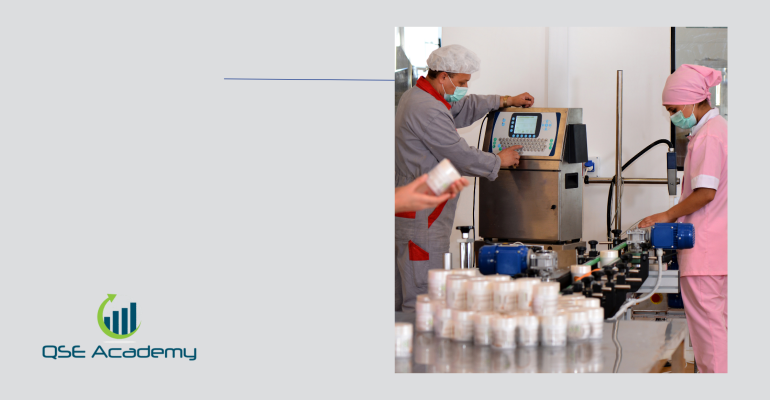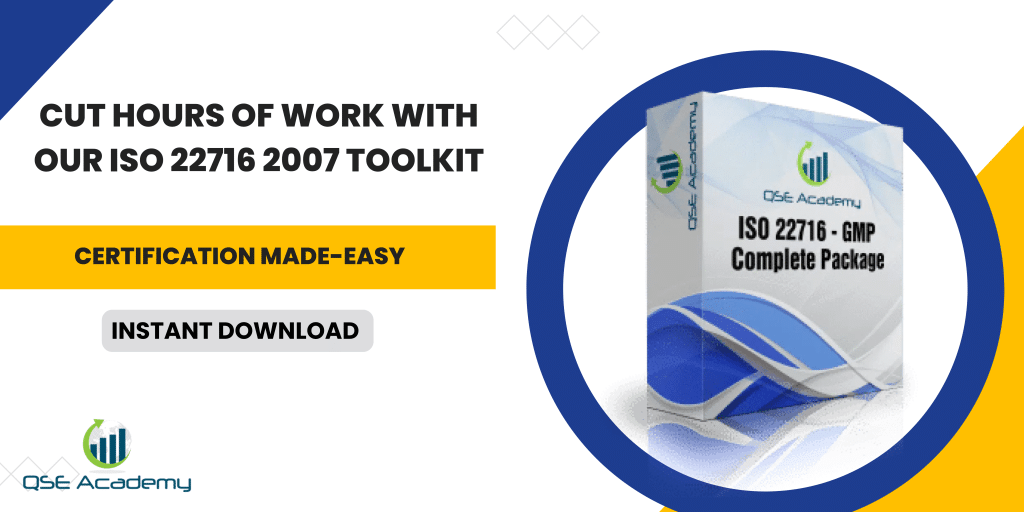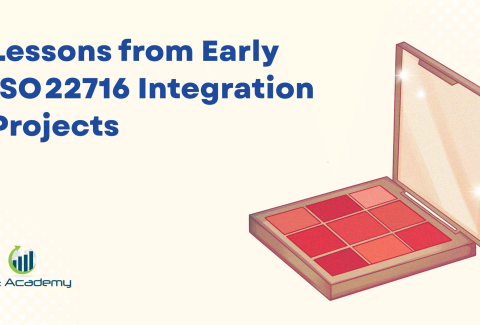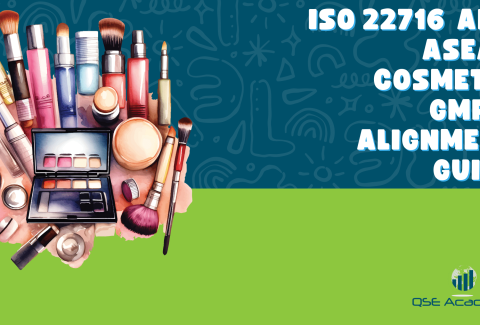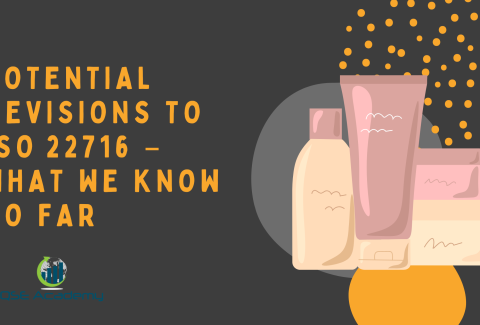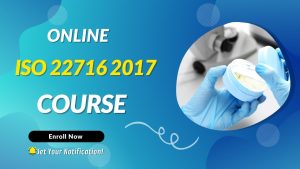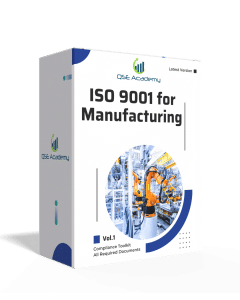ISO 22716 Audit Checklist
Last Updated on October 24, 2025 by Hafsa J.
ISO 22716 Audit Checklist
If you’re preparing for ISO 22716 certification, you’ve probably realized how much there is to keep track of. From hygiene standards to proper documentation, the process can feel overwhelming at first. That’s where an ISO 22716 audit checklist comes in—it’s your secret weapon to staying organized and ensuring you’re covering all the bases.
Think of the ISO 22716 audit checklist as a detailed roadmap. It helps you identify what needs attention, guides you through the requirements, and ensures you don’t overlook any critical details during the audit process. Whether you’re conducting an internal review or gearing up for the official certification audit, having a solid checklist makes the entire journey smoother and less stressful.
In this guide, we’ll break down everything you need to know about creating and using an ISO 22716 audit checklist, including key components to include and tips for making the most of it. By the end, you’ll have a clear plan to navigate your way to ISO 22716 compliance with confidence. Ready to dive in? Let’s get started!
What is an ISO 22716 Audit Checklist?
If you’re wondering what an ISO 22716 audit checklist is and why it’s so important, you’re in the right place. Simply put, this checklist is a tool that helps you stay organized and ensure your business complies with ISO 22716, the international standard for Good Manufacturing Practices (GMP) in the cosmetics industry.
The Purpose of an ISO 22716 Audit Checklist
The primary goal of an ISO 22716 audit checklist is to guide you through the key requirements of the standard, step by step. Think of it as a safety net—it helps you identify gaps in your processes, address any non-conformities, and prepare for both internal and external audits.
For example, the checklist might include items like:
- Are hygiene protocols being consistently followed?
- Are raw materials stored under appropriate conditions?
- Is documentation for each batch complete and accurate?
By addressing these points, the checklist ensures that no critical details slip through the cracks, which is especially helpful when preparing for your certification audit.
Who Needs an ISO 22716 Audit Checklist?
Here’s the thing: whether you’re a small cosmetics startup or a large-scale manufacturer, an ISO 22716 audit checklist can be a game-changer.
- For Quality Managers: It provides a structured way to review processes and confirm compliance.
- For Manufacturing Teams: It clarifies expectations and ensures day-to-day operations align with ISO 22716 requirements.
- For Auditors: It serves as a reference point to evaluate whether the business is meeting the standard.
In short, anyone involved in ensuring product safety and quality in the cosmetics industry can benefit from using an ISO 22716 audit checklist.
Why is an ISO 22716 Audit Checklist Essential?
Let’s be honest—preparing for an audit can feel overwhelming. There are so many details to consider, and it’s easy to overlook something important. That’s why having an ISO 22716 audit checklist is so valuable.
- Saves Time: Instead of scrambling to figure out what’s required, you can use the checklist to stay focused and organized.
- Reduces Stress: Knowing you’ve covered every aspect of the standard gives you peace of mind.
- Boosts Confidence: When it’s time for your certification audit, you’ll be fully prepared to demonstrate compliance.
Whether you’re just starting your ISO 22716 journey or gearing up for your final audit, having a reliable checklist in place makes the entire process more manageable—and dare I say, even a little less intimidating!
Now that we know why an ISO 22716 audit checklist is so important, let’s dive into the specific components that should be included. Trust me, you’re going to want to stick around for this part!
Key Components of an ISO 22716 Audit Checklist
Now that we’ve covered what an ISO 22716 audit checklist is and why it’s essential, let’s break it down into its key components. Think of this section as the foundation of your checklist—the critical areas you’ll need to address to ensure compliance with ISO 22716 standards. By focusing on these elements, you’ll be well-prepared for any internal or external audit.
1. Hygiene and Sanitation Standards
One of the most important sections of your ISO 22716 audit checklist is hygiene. Maintaining a clean and sanitary environment is non-negotiable in the cosmetics industry, and this standard makes it a top priority.
Key checklist items:
- Are hygiene protocols in place for all employees, such as wearing protective clothing and frequent handwashing?
- Is the production area regularly cleaned and sanitized according to documented procedures?
- Are there measures to prevent cross-contamination between batches or products?
By ensuring strict hygiene practices, you’re not just meeting ISO 22716 requirements—you’re also protecting your products and customers.
2. Documentation and Record-Keeping
Proper documentation is a cornerstone of ISO 22716. Your ISO 22716 audit checklist should include items that ensure you’re maintaining accurate, thorough, and up-to-date records.
Key checklist items:
- Are batch production records complete and accessible?
- Are all raw materials and finished products properly documented, including lot numbers and storage conditions?
- Is there a system in place to track non-conformities and corrective actions?
Keeping your records organized not only supports compliance but also makes it easier to address issues quickly if they arise.
3. Quality Control Processes
Your ISO 22716 audit checklist should also focus on quality control to ensure that every product meets the highest standards. This involves testing raw materials, monitoring production, and inspecting finished products.
Key checklist items:
- Are raw materials inspected and tested before use?
- Are there quality control checks at critical points during production?
- Are finished products tested for compliance with specifications before release?
By prioritizing quality control, you’re demonstrating a commitment to delivering safe, reliable products to your customers.
4. Employee Training and Competency
Your team plays a huge role in maintaining compliance, so training and competency should be a key focus of your checklist. After all, even the best processes won’t work if your team doesn’t understand them!
Key checklist items:
- Are employees trained in Good Manufacturing Practices (GMP) and aware of their roles and responsibilities?
- Are training records maintained and updated regularly?
- Do employees understand and follow hygiene and safety protocols?
Regular training ensures that your team is equipped to support compliance and handle audits with confidence.
5. Facility and Equipment Maintenance
Another critical section of your ISO 22716 audit checklist is facility and equipment management. This ensures that your production environment and tools meet the standards for safety and cleanliness.
Key checklist items:
- Are equipment maintenance schedules documented and followed?
- Is the facility designed to minimize contamination risks (e.g., separate areas for raw materials and finished products)?
- Are storage areas properly organized and temperature-controlled, if necessary?
Well-maintained facilities and equipment are essential for consistent product quality and safety.
6. Storage and Distribution
Your audit checklist should also address how products are stored and distributed. Proper storage and handling ensure that products remain safe and effective throughout their lifecycle.
Key checklist items:
- Are raw materials and finished products stored under the correct conditions to prevent contamination or degradation?
- Are distribution records maintained to ensure traceability?
- Are storage areas regularly inspected for compliance with cleanliness and organization standards?
Bringing It All Together
By including these components in your ISO 22716 audit checklist, you’ll have a comprehensive guide to help you prepare for audits and maintain compliance. From hygiene to record-keeping, quality control to training, every item on your checklist plays a crucial role in ensuring your business meets the highest standards.
Next, we’ll dive into how to use this checklist effectively to make your audit process as smooth and stress-free as possible. Stay tuned—you’re on the right track!
How to Use an ISO 22716 Audit Checklist Effectively
So, now that you know what an ISO 22716 audit checklist should include, let’s talk about how to actually use it. A checklist is only as good as the way it’s applied, so having a plan to use it effectively is key. Whether you’re preparing for an internal review or an external certification audit, these tips will help you make the most of your checklist and streamline the process.
1. Start with a Pre-Audit Review
The best time to use your ISO 22716 audit checklist is before an official audit. This pre-audit review gives you the chance to evaluate your current practices and identify any gaps before an auditor steps in.
How to do it:
- Go through each item on your checklist one by one, inspecting your processes, facilities, and documentation.
- Take notes on areas where you fall short, such as incomplete records or missing employee training logs.
- Use your findings to create a corrective action plan so you can address issues before the official audit.
By tackling gaps early, you’ll feel more confident and prepared when it’s time for the real thing.
2. Involve Your Team
Your ISO 22716 audit checklist shouldn’t be a solo project. Involving your team ensures that everyone understands the requirements and plays their part in meeting them.
How to do it:
- Assign specific sections of the checklist to different team members based on their roles. For example, your quality manager might handle the documentation section, while production staff focus on hygiene practices.
- Hold a team meeting to review the checklist and explain why each item is important.
- Encourage your team to ask questions and provide feedback—it’s a great way to identify practical improvements.
When everyone is on the same page, it makes the audit process smoother and more efficient.
3. Keep the Checklist Accessible
Your ISO 22716 audit checklist isn’t something you should use once and forget about. It should be a living document that’s easily accessible to your team and integrated into your daily operations.
How to do it:
- Store the checklist in a shared digital space, such as a cloud-based platform, so everyone can access it when needed.
- Update the checklist regularly to reflect changes in ISO 22716 standards, company processes, or feedback from previous audits.
- Use the checklist during routine inspections or internal audits to ensure ongoing compliance.
Having a central, up-to-date checklist keeps everyone aligned and prevents last-minute scrambling before an audit.
4. Use It as a Training Tool
A good ISO 22716 audit checklist can double as a training resource. It helps employees understand what’s expected of them and how their roles contribute to compliance.
How to do it:
- Incorporate the checklist into new employee onboarding to familiarize them with your processes.
- Use specific items on the checklist to guide refresher training sessions, such as hygiene protocols or documentation practices.
- Highlight areas of improvement based on past audit results to keep your team focused and motivated.
By turning your checklist into a learning tool, you’re reinforcing best practices across the board.
5. Track and Resolve Non-Conformities
One of the key benefits of an ISO 22716 audit checklist is that it helps you identify non-conformities—areas where your practices don’t meet the standard. Addressing these issues promptly is critical for maintaining compliance.
How to do it:
- Document any non-conformities found during your checklist review.
- Develop a corrective action plan that outlines what needs to be fixed, who is responsible, and a timeline for completion.
- Follow up to ensure the corrective actions have been implemented and resolved effectively.
This proactive approach shows auditors that you take compliance seriously and are committed to continuous improvement.
6. Use the Checklist to Prepare for External Audits
When it’s time for your official certification audit, your ISO 22716 audit checklist will be your best friend. It ensures you’ve covered all the requirements and gives you a clear plan to present to auditors.
How to do it:
- Conduct a final checklist review a few weeks before the external audit.
- Gather all necessary documentation, such as training records, batch logs, and maintenance schedules, so they’re easy to access during the audit.
- Practice answering potential auditor questions using the checklist as a guide.
When you’ve prepared thoroughly, the audit will feel less intimidating, and you’ll be ready to showcase your compliance with confidence.
Why Effective Checklist Use Matters
Using your ISO 22716 audit checklist effectively isn’t just about ticking boxes—it’s about creating a structured, proactive approach to compliance. By integrating the checklist into your daily operations, involving your team, and tracking progress, you’re setting yourself up for long-term success.
Up next, we’ll dive into some common challenges businesses face with audit checklists and how to overcome them. Trust me, you’re well on your way to mastering this process!
Common Challenges with Using an ISO 22716 Audit Checklist
While an ISO 22716 audit checklist is an incredibly helpful tool, using it effectively isn’t always a walk in the park. Like anything in business, there are bound to be a few bumps along the way. But don’t worry—these challenges are manageable once you know what to expect. Let’s explore some common hurdles businesses face with their audit checklists and how to overcome them.
1. Overlooking Minor Details
One of the biggest challenges with an ISO 22716 audit checklist is the temptation to focus only on the obvious, big-ticket items while overlooking smaller details. However, it’s often the little things—like incomplete documentation or inconsistent hygiene practices—that can cause the most trouble during an audit.
How to Overcome It:
Take your time with the checklist. Break it down into smaller sections and review each one thoroughly. For example, don’t just skim over the hygiene protocols—check if employees are consistently following them. Consider assigning specific team members to focus on these finer details to ensure nothing is missed.
2. Lack of Team Engagement
Another challenge is getting your team fully on board with the audit checklist. If employees view it as “just another task,” they may not give it the attention it deserves, which can lead to gaps in compliance.
How to Overcome It:
Help your team understand why the ISO 22716 audit checklist is important—not just for the business but for their roles, too. Explain how it contributes to product safety, quality, and customer trust. You can also make the process more engaging by involving them in creating or updating the checklist, so they feel a sense of ownership.
3. Managing Time and Resources
Using an ISO 22716 audit checklist effectively takes time and effort, which can be a challenge if you’re already juggling a busy production schedule.
How to Overcome It:
Incorporate the checklist into your regular routines rather than treating it as a one-off task. For instance, you could schedule a weekly or monthly review of specific sections, like hygiene protocols or documentation. This approach makes the process more manageable and prevents last-minute scrambling before an audit.
4. Keeping the Checklist Updated
Standards like ISO 22716 evolve over time, and so do your business processes. If your checklist isn’t updated regularly, you risk falling behind on compliance or missing new requirements.
How to Overcome It:
Make it a habit to review and update your ISO 22716 audit checklist at least once a year—or whenever there’s a change in the standard or your operations. Assign someone on your team to oversee this process and ensure the checklist remains current and relevant.
5. Struggling with Non-Conformities
Identifying non-conformities using your checklist is one thing, but addressing them effectively can be a challenge. It’s easy to feel stuck or overwhelmed when trying to fix issues, especially if they’re complex.
How to Overcome It:
Treat non-conformities as opportunities for improvement. Create a clear corrective action plan that outlines what needs to be done, who will do it, and when it will be completed. Keep communication open with your team to ensure everyone is aligned on the next steps. Remember, auditors appreciate seeing how you’ve addressed past issues—it shows your commitment to continuous improvement.
6. Overcomplicating the Process
Sometimes, businesses try to include too much detail in their ISO 22716 audit checklist, making it overly complex and difficult to use. While thoroughness is important, an overly complicated checklist can slow you down.
How to Overcome It:
Focus on creating a checklist that’s detailed but easy to follow. Use clear, concise language and group related items together for simplicity. If you’re using a digital checklist, take advantage of features like dropdown menus or checkboxes to make it more user-friendly.
7. Balancing Day-to-Day Operations with Audit Prep
Let’s face it—preparing for an audit while running a business is no small feat. Finding the balance between daily operations and audit readiness can feel like a juggling act.
How to Overcome It:
Integrate the audit checklist into your normal workflows. For example, assign sections of the checklist to specific departments or roles, so everyone is contributing without it becoming a burden. By spreading the responsibility, you can maintain compliance without disrupting day-to-day activities.
Why Addressing These Challenges Matters
Using an ISO 22716 audit checklist isn’t just about passing an audit—it’s about creating a culture of quality and continuous improvement within your business. By addressing these challenges head-on, you’ll not only make the checklist more effective but also set your business up for long-term success.
In the next section, we’ll explore how you can customize your checklist to fit your specific needs and make it even more impactful. Stay tuned—you’re doing great!
Creating a Custom ISO 22716 Audit Checklist for Your Business
If there’s one thing to know about the ISO 22716 audit checklist, it’s that no two businesses are exactly alike. While a standard checklist can give you a great starting point, customizing it to fit your specific processes, team, and products will make it even more effective. Let’s talk about how you can create a tailored checklist that works perfectly for your unique needs.
1. Start with the Basics
Every ISO 22716 audit checklist should cover the key requirements of the standard, like hygiene, documentation, and quality control. These are the non-negotiables that apply to all cosmetics manufacturers.
How to do it:
- Use a general ISO 22716 checklist as your foundation.
- Include must-have items like cleanliness protocols, raw material handling, and employee training.
- Make sure your checklist addresses the core components we discussed earlier, such as facility maintenance and product storage.
Think of this as your checklist’s skeleton—it gives you the structure you need to build on.
2. Add Business-Specific Details
Now it’s time to personalize your ISO 22716 audit checklist. What makes your business unique? Maybe you work with specialized ingredients, or perhaps your production involves complex formulations. These details need to be reflected in your checklist.
How to do it:
- Consider the specific products you make. For example, if you produce skincare items, your checklist might include extra steps for ensuring product stability.
- Include any equipment or processes that are unique to your operations, such as specialized machinery or packaging methods.
- Tailor hygiene and quality control checks to fit your facility’s layout and workflow.
By making your checklist reflect the reality of your day-to-day operations, you’ll ensure it’s practical and relevant.
3. Involve Your Team
Your employees are the ones who will be using the checklist and implementing its guidelines, so their input is invaluable. Involving them in the customization process can also make them more engaged and invested in compliance.
How to do it:
- Host a brainstorming session with key team members to discuss what should be included in the checklist.
- Ask for feedback on any current pain points or gaps they’ve noticed in existing processes.
- Assign specific team members to review and test the checklist to make sure it’s user-friendly and effective.
When your team feels like they’ve had a say in the process, they’re more likely to follow through with it.
4. Keep It Clear and Simple
While it’s important to be thorough, your ISO 22716 audit checklist should also be easy to understand and use. Overloading it with unnecessary detail can make the process feel overwhelming, so focus on clarity and simplicity.
How to do it:
- Use straightforward language—no jargon or overly technical terms.
- Group related items together under clear headings, like “Hygiene Practices” or “Quality Control.”
- If you’re using a digital checklist, incorporate features like dropdown menus or color-coded sections to make navigation easier.
A clean, organized checklist is much more likely to be used effectively.
5. Include Examples and Reference Materials
Sometimes, a little extra guidance can go a long way. Including examples or references in your ISO 22716 audit checklist can help clarify what’s expected and reduce confusion.
How to do it:
- Add specific examples for certain items. For instance, under “Hygiene Practices,” you could include a note like, “Employees must wash hands before entering the production area and wear gloves when handling raw materials.”
- Reference relevant documents or procedures, such as SOPs (Standard Operating Procedures) or training manuals.
- Provide links to digital resources if your checklist is online.
By adding this level of detail, you’re giving your team the tools they need to succeed.
6. Test and Refine
Once you’ve customized your ISO 22716 audit checklist, don’t assume it’s perfect right out of the gate. Testing it in real-world scenarios is the best way to identify areas for improvement.
How to do it:
- Use the checklist during a mock audit or internal review and take note of any issues or gaps.
- Gather feedback from your team on what’s working and what could be improved.
- Update the checklist as needed to reflect changes in your processes or ISO 22716 requirements.
Remember, your checklist is a living document—it should evolve alongside your business.
7. Align It with Your Long-Term Goals
Finally, think about how your ISO 22716 audit checklist fits into your bigger picture. Is your business growing? Are you entering new markets? Customizing your checklist to align with your goals will make it a valuable tool for the long haul.
How to do it:
- Add items that prepare you for future expansion, like enhanced quality control measures or advanced training programs.
- Use the checklist to track progress and measure improvement over time.
- Regularly review it to ensure it continues to meet your business needs.
By keeping your checklist aligned with your vision, you’ll ensure it remains a powerful asset as your business evolves.
Why Customization Matters
Creating a custom ISO 22716 audit checklist isn’t just about compliance—it’s about making the standard work for your unique business. When your checklist reflects your specific operations, team, and goals, it becomes a practical, effective tool for ensuring quality and safety every step of the way.
In the next section, we’ll explore how technology can make your checklist even more powerful and efficient. Stay tuned—you’re doing great!
The Role of Technology in ISO 22716 Audit Checklists
Let’s face it—managing an ISO 22716 audit checklist manually can feel like juggling too many things at once. The good news? Technology can take a lot of the stress out of the process. By using digital tools, you can streamline your checklist, improve accuracy, and make audits far less daunting. Let’s dive into how technology can revolutionize the way you handle your ISO 22716 audit checklist.
1. Go Digital for Better Organization
A digital ISO 22716 audit checklist keeps everything in one place, making it easy to access and update. Whether it’s stored in the cloud or a dedicated audit management app, having your checklist online ensures that you and your team are always working with the most current version.
Benefits:
- No more lost or outdated paper checklists.
- Quick updates whenever ISO 22716 standards or your processes change.
- Centralized storage for notes, records, and photos related to audits.
Imagine being able to pull up your checklist on a tablet during a facility walk-through—it’s not just convenient; it also looks super professional during an external audit.
2. Automate Routine Tasks
One of the biggest advantages of using technology with your ISO 22716 audit checklist is automation. Software tools can handle repetitive tasks like reminders, tracking progress, and even generating reports.
How It Helps:
- Set automatic alerts to remind your team about upcoming audits or corrective actions.
- Use built-in features to flag incomplete sections of the checklist.
- Generate detailed audit reports with just a few clicks, saving you hours of manual work.
Automation isn’t about replacing your team—it’s about giving them the tools to focus on what matters most.
3. Improve Traceability with Real-Time Data
Traceability is a huge part of ISO 22716 compliance, and technology makes it easier than ever to track and record every step of your processes. A digital ISO 22716 audit checklist can integrate with other systems, like inventory management or quality control, to ensure real-time updates.
Why It’s Important:
- You’ll always know the status of raw materials, batches, and products.
- Auditors will appreciate the ability to quickly access traceability data during an inspection.
- Real-time tracking minimizes the risk of errors or missing information.
Having accurate, up-to-date data at your fingertips is a game-changer when preparing for an audit.
4. Track Non-Conformities and Corrective Actions
Dealing with non-conformities is a natural part of the audit process, but technology makes it much easier to manage them. Many audit management tools include features for tracking issues and ensuring they’re resolved promptly.
How It Works:
- Log non-conformities directly into your digital checklist.
- Assign corrective actions to specific team members and set deadlines for completion.
- Monitor the status of corrective actions and document the resolution for future reference.
This approach not only keeps you organized but also demonstrates to auditors that you’re proactive about continuous improvement.
5. Enhance Collaboration Across Teams
An ISO 22716 audit checklist isn’t something you manage alone—it’s a team effort. Technology can help everyone stay on the same page, even if your team is spread across different locations or departments.
Features to Look For:
- Shared access to the checklist, so everyone can contribute and stay updated.
- Commenting or tagging features to ask questions or provide context.
- Role-based permissions to control who can view or edit specific sections of the checklist.
Collaboration tools make it easy to work together, whether you’re prepping for an internal audit or hosting an external one.
6. Analyze and Improve with Insights
One of the coolest things about using technology for your ISO 22716 audit checklist is the ability to analyze data and identify trends. Many digital tools come with dashboards or analytics features that give you a bird’s-eye view of your compliance efforts.
What You Can Learn:
- Common non-conformities or areas that need improvement.
- How your team is performing over time.
- Opportunities to streamline processes or enhance training programs.
Using this data, you can make smarter decisions and continuously improve your operations.
7. Make Audits Less Stressful
Finally, technology takes a lot of the stress out of audits by making the process smoother and more transparent. With a digital ISO 22716 audit checklist, you’ll always be prepared, and your auditors will appreciate the streamlined, professional approach.
Benefits for Auditors:
- Easy access to all relevant documentation and records.
- Clear tracking of corrective actions and resolutions.
- Confidence in your ability to maintain compliance over time.
By reducing manual errors and improving efficiency, technology ensures that audits become less of a headache and more of a routine check-in.
Why Technology is a Must for ISO 22716 Audits
Incorporating technology into your ISO 22716 audit checklist isn’t just a nice-to-have—it’s a smart move that saves time, reduces errors, and makes compliance easier. Whether you’re automating tasks, enhancing collaboration, or improving traceability, the right tools can transform your approach to audits and set your business up for long-term success.
In the next section, we’ll wrap up everything we’ve covered and highlight why an ISO 22716 audit checklist is your ultimate compliance tool. Stay tuned—you’re almost there!
Conclusion: The Value of an ISO 22716 Audit Checklist
We’ve covered a lot about the ISO 22716 audit checklist, and by now, it’s clear just how valuable this tool is for navigating the certification process. Whether you’re preparing for your first audit, conducting routine internal checks, or maintaining compliance over time, a well-designed checklist makes everything smoother and more manageable.
The beauty of an ISO 22716 audit checklist is its ability to guide you through every key aspect of the standard. From hygiene practices and quality control to documentation and training, the checklist ensures that you’re not missing any critical details. It’s like having a trusted companion by your side, helping you stay organized and confident throughout the journey.
Why an ISO 22716 Audit Checklist Matters
Let’s take a moment to reflect on why this checklist is so important:
- It simplifies a complex process by breaking down ISO 22716 requirements into manageable steps.
- It ensures that you’re always prepared, whether you’re facing an internal review or an external certification audit.
- It helps you identify and address non-conformities, paving the way for continuous improvement.
- It boosts your team’s confidence and engagement by providing clear guidance and expectations.
Most importantly, using an ISO 22716 audit checklist is about building a culture of safety, quality, and compliance within your business. It’s not just about passing audits—it’s about creating processes that ensure your cosmetics are safe, reliable, and meet the highest standards.
Next Steps: Putting Your Checklist into Action
So, what’s next? Now that you understand the importance of an ISO 22716 audit checklist, it’s time to put it into action. Here’s a quick recap of what you can do:
- Create or customize your checklist to fit your unique business needs.
- Involve your team in the process to ensure buy-in and collaboration.
- Use technology to make your checklist more efficient, accessible, and effective.
- Stay proactive by regularly updating and reviewing your checklist to reflect changes in standards or processes.
Remember, the checklist isn’t just a one-time tool—it’s an ongoing resource that will support your compliance efforts for years to come.
Why You’re Ready to Succeed
Preparing for ISO 22716 certification or maintaining compliance might seem like a big task, but with the right tools and mindset, it’s absolutely achievable. Your ISO 22716 audit checklist is your roadmap, your safety net, and your key to success in the cosmetics industry.
So go ahead—dive into the process with confidence! Whether you’re starting small or tackling major improvements, every step you take with your checklist brings you closer to your goal. You’ve got this, and your business will be stronger for it.
If you’re ready to take the next step or have any questions, I’m here to help. Let’s make your ISO 22716 journey a success!
Whether it’s ISO 9001, ISO 22000, or the cosmetics-focused ISO 22716, I’ve spent my career I’m not here to call myself an expert—I prefer “enthusiast” because I truly love what I do. When I’m not writing about standards, you’ll probably find me playing Piano 🎹, connecting with people, or diving into my next big project💫. I’m an engineer specialized in the food and agricultural industry
make ISO standards less intimidating and more approachable for everyone.
turning complex jargon into clear, actionable steps that businesses can actually use.
There’s something incredibly rewarding about helping people navigate food safety and quality management systems
in a way that feels simple, practical, and even enjoyable.
I have a Master’s in QHSE management and over 12 years of experience as a Quality Manager
I’ve helped more than 15 companies implement ISO 9001, ISO 22000, ISO 22716, GMP, and other standards
My clients include food producers, cosmetics manufacturers, laboratories, and service companies
I believe quality systems should be simple, useful, and efficient.
Looking for More Resources on ISO 22716?
If you found this article helpful, explore our premium resources designed to help you achieve ISO 22716 certification efficiently:
- Complete Documentation Package for ISO/IEC 22716 2017: Get all the essential templates and documents you need for fast, easy implementation.
- Online Course on ISO/IEC 22716 2017 : Enroll in our comprehensive training to master the key concepts and practical steps toward certification.
- ISO/IEC 22716 2017 Checklist: Download our detailed checklist to ensure you’ve covered every step of the process.
These resources are tailored to meet your needs and ensure a smooth certification journey. Explore them today and get one step closer to success!

